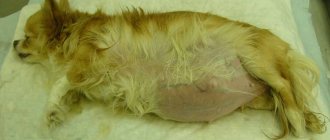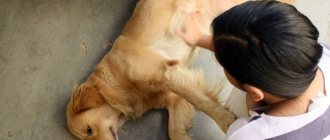The birth of babies is a special moment in the life of every owner and his pet. Often, first-time owners begin to panic during their dog's labor, finding themselves unable to help when needed. To overcome your fear and deliver a dog at home, you just need to know a few simple things. The main thing is not to worry and be well prepared.
Symptoms of approaching labor
The entire period of labor can be divided into three main stages:
- Preparation of the birth canal;
- Uterine contractions;
- The process of expulsion of puppies from the uterus and the birth of the placenta.
Each of these stages has certain signs that help the breeder navigate at what stage the birth process is occurring.
Opening of the birth canal
At this stage, the bitch's intraperitoneal pressure increases. Contractions are rare and practically painless. However, the animal experiences severe anxiety and its behavior becomes unusual.
The dog is anxious, constantly changes its body position, gets up, lies down, and may often ask to go outside, but immediately returns to the house. Many individuals try to retire in dark places and actively dig the litter. Vomiting, complete refusal to eat, or increased appetite may occur. Obsessive attention to the owner is caused by unpleasant sensations and the dog seeks support and help from the owner.
In addition to changes in behavioral reactions, the pet undergoes a number of physiological changes that can tell the owner that labor is approaching.
- Within 4-5 days, the stomach sags and seems to sink down. This is due to the relaxation of the ligamentous apparatus necessary for the passage of puppies through the birth canal and through the pelvic bones. It is important to understand that in animals giving birth for the first time, this sign may not fully manifest itself.
- A decrease in body temperature also indicates the approach of a crucial moment. Normally, the temperature in animals is 38-39 degrees, and before birth, 8-12 hours before birth it drops to 37-37.5.
- The animal is trembling and showing signs of chills.
- The onset of labor is also indicated by the discharge of grayish-white mucus and the softening of the loop.
It is important! Normally, the duration of the first stage ranges from 2 to 24 hours . If labor does not begin after a day, then consultation with a specialist is necessary!
Contractions in a dog
At this stage, intense contractions can be observed in the bitch. They are manifested by contractions of the abdominal muscles. When trying to place a hand on the pet's side, the breeder feels the uterus tense at the moment of contraction, and then relaxes. In most cases, the bitch whelps lying on her right side. But some individuals prefer to do this while standing. With intense and painful attempts, the dog whines.
Birth of puppies and placenta
The first sign that the puppy is about to be born is when your water breaks. Each baby develops in an individual membrane, which is called the amniotic sac. All together the puppies are enclosed in a single bubble (water). It contains a jelly-like mass that provides the necessary lubrication and protection of the birth canal.
This lubricant serves as a kind of “washer” of the birth canal. With increasing intraperitoneal pressure, the bladder wedges into the birth canal and then ruptures. It ruptures during childbirth. The second bladder, filled with amniotic fluid, ruptures after the puppy is born. During labor, contractions become more intense and painful, and the interval between them decreases.
It is important! 2-2.5 hours should pass from the moment the water breaks until the birth of the first puppy . If the puppy does not appear, then it is necessary to urgently use the services of a veterinarian. This state of affairs indicates that complications have arisen.
How long does labor last in dogs?
Experts do not give a clear answer to this question. The duration of the birth process is directly related to the physical form of the animal, its age, living conditions, the number and size of puppies, as well as their presentation, etc.
The average duration of labor varies from 6 to 8 hours .
At the same time, some individuals experience rapid labor, while other dogs can whelp for about a day and physiologically the process proceeds completely normally.
At home or in a clinic?
The most important question for owners of a pregnant dog is: should they give birth on their own or go to a veterinary clinic? Let's figure out how and in what cases it is better to do.
It is advisable to contact a veterinary hospital in the following situations:
- You have no experience in giving birth.
- You are very afraid. The fact is that your fear can affect the emotional state of the dog, and if your help is needed in such a state, you most likely will not be able to do it adequately and correctly.
- First birth. Or before that they passed with complications.
- Small dog (up to 4 kg). These dogs are more likely to have difficulty giving birth.
Important! If it is possible to call a veterinarian at home, then this will be the best option for your dog.
At home, this process will bring less stress to your pet. Giving birth at home:
- Do you have experience in giving birth to a dog?
- The dog has already given birth successfully.
- You know what needs to be done and are ready to help correctly.
- Large animal. In such dogs, childbirth is usually easy and without complications.
If this is exactly the situation you have, then you can safely prepare to give birth on your own. But to be on the safe side, before labor begins, you should at least have the phone number of a specialist who can advise you.
How to prepare for childbirth
The process of preparing for childbirth includes two main stages:
- Site preparation;
- Purchase of necessary drugs and instruments;
Let's consider each of them to get the most complete picture of events.
Preparing the place for birth and subsequent maintenance of puppies
Experienced breeders recommend preparing a place for whelping and keeping puppies in advance. The optimal solution would be 1.5-2 weeks before the expected moment of delivery. This will allow the bitch to get used to the new place and will relieve some of the stress when trying to place her in a new “nest” during the whelping process.
Secluded areas should be chosen to create a birthing area. It is ideal if a layer of thermal insulation is laid between the floor and the bed or box. This will reduce the negative impact of drafts and relieve pets from hypothermia in the winter. One side of the box or bed should be slightly lower than the others. Thanks to this, the animal can easily leave the bed or box. At the same time, the kids will not be able to get out of there on their own.
Blankets used during the whelping process most often become unsuitable for subsequent use and breeders simply throw them away. during the birth process, you will have to throw it out. It is also better to clear the room of carpets, since the process of giving birth to puppies can hardly be called impeccably clean.
It is important! in the cold season, it is necessary to take care of the nest heating system. A regular heating pad or heater does this job well.
The optimal temperature in the nest should be within 28 degrees during the first 10-12 days. And only after the above period it can be gradually increased to 20 degrees.
Preparing instruments and medications
Experienced breeders who plan to give birth to a dog themselves prepare a special set of tools and medications in advance. It will help save time searching for necessary items and allow you to pay maximum attention to the giving birth bitch.
Essential items include:
- Oilcloths, sheets, as well as diapers for the bitch and a basin where all this will be folded after use;
- Old clothes in which you will give birth;
- A water or electric heating pad placed in a small box. It will play the role of a temporary nest for the babies so that they do not disturb the dog during the whelping process;
- A thermometer for determining the bitch’s body temperature and a second one for determining the microclimate in the room;
- Pre-sterilized tweezers, pipette, scissors. Processing is carried out by boiling. The manipulation takes 5-7 minutes. The lid should tightly cover the pan with the tools;
- Syringes and sterile gauze pads for treating the injection site;
- Diapers for wiping puppies;
- Sterile suture material or silk threads placed in a glass with medical alcohol or vodka. They will be needed to tie the umbilical cord;
- Scales for determining the weight of puppies, a notepad and pen for recording information about the offspring, a watch for tracking the dynamics of labor. Multi-colored woolen threads will also come in handy, which will allow you to mark the puppies if they have a similar color and lack characteristic features.
The above items, prepared in advance, will help save time and eliminate the risk of panic and confusion during the birth of offspring.
Experts include the following among the necessary medications:
- Medical alcohol;
- 5% glucose solution;
- Syntomycin ointment 10%;
- Hydrogen peroxide and brilliant green solution.
It would also be a good idea to stock up on the veterinarian’s number in advance and discuss with him the possibility of an emergency call.
Place for puppies
The box where the puppies will live for the first month should be of such a size that the bitch can easily turn over in it, stand up to her full height, and stretch out in all directions so that there is still room for the puppies. The box should have no top (instead of a “roof,” a diaper is placed on top and secured to the cardboard with clothespins). The entrance to the “den” must be cut at such a height from the floor that the bitch can easily enter inside, and the puppies cannot crawl out. A mattress is laid at the bottom of the box, which is “packed” in a plastic bag, and on top of the bag - in a soft, thick pillowcase.
Important:
the cardboard box should not be too large, since in a spacious “den” it is more difficult to maintain the optimal temperature.
How to deliver a dog
If the animal is in good shape and this is not the first birth, then it is quite capable of coping on its own. In the case of the first birth, the help of a breeder will be required, who must understand exactly what needs to be done and how.
When signs of whelping appear, the owner should bathe the pet, cleaning the fur in the area of the loop and anus.
Terriers and other animals with thick beards and mustaches can be trimmed to make it easier to bite the umbilical cord.
Providing assistance consists of several simple steps:
Freeing the puppy from the amniotic sac
If the bitch does not do this herself, then you should quickly and carefully break the bubble, then free the baby’s mouth and nose from mucus. When a baby is born with blood or mucus, it is necessary to immediately suck it out of the puppy’s respiratory tract using a syringe or pipette. This will allow oxygen to pass freely into the lungs.
Cutting the umbilical cord
If the bitch does not bite the umbilical cord on her own, the breeder should pick up the puppy and gently and quickly squeeze the blood out of the umbilical cord towards the puppy. Then, 2-3 cm from the baby’s belly, tie the umbilical cord with a strong thread and cut it off thread by thread.
It is important! Do not cauterize the umbilical cord with iodine if blood appears.
Placenta department
After the birth of each puppy, the number of placenta should be carefully monitored. It must exactly correspond to the number of offspring. If there is even the slightest possibility of incomplete discharge of the placenta, then consultation and examination by a veterinarian is required! Otherwise, the likelihood of inflammatory processes, the development of endometritis, etc. increases.
It is important! After the birth of each puppy, it is necessary to change the bedding and avoid a situation where the dog lies in a wet and dirty place.
Otherwise, the likelihood of infection of the genital tract and deterioration of the bitch’s condition during the postpartum period increases.
Postpartum period
The postpartum period is the time after the delivery of the placenta until the uterus is restored. Uterine discharge can last up to three weeks. At first they are greenish or brown with a neutral odor, later they become transparent. Pathologies are the depressed state of the mother, foul-smelling discharge.
It is necessary to provide the mother with a balanced diet and special vitamins. The dog needs to be fed at least 6 times a day in medium portions. Give milk or water every 2-3 hours.
The owner must know how to understand that his dog is giving birth, and how they are born in principle. This knowledge will help save the animal in case of complications, and therefore you should approach this process with confidence.
Complications during childbirth
Not all childbirth processes go smoothly. Possible complications include:
- Lack of opening of the birth canal;
- Absence of uterine contractions, which are called contractions;
- Weak labor;
- Incorrect presentation of puppies;
- Excessively large puppies with a fragile female constitution;
- Bleeding, etc.
At the first signs of complications, you should immediately seek help from a veterinarian; in some cases, delay can cause the death of the bitch and offspring.
Rehabilitation after childbirth
The rehabilitation process for a strong and healthy animal does not last long. After just a few days, the bitch becomes more active and mobile. But for 2-3 weeks you should avoid excessive physical activity and strengthen your diet.
The animal requires more high-calorie and easily digestible food. A special diet for lactating and pregnant bitches is well suited. If the pet is on a natural diet, then dairy products, meat, and cottage cheese should be included in the daily diet. The bitch should be given a vitamin and mineral supplement rich in calcium, vitamin D and Omega-3 fatty acids.
When walking in the cold season, you can wear a bandage or overalls, which will prevent hypothermia of the mammary glands and the development of mastitis. Maintaining optimal temperature conditions in the room where the dog is located will reduce the risk of hypothermia and speed up the rehabilitation process.











